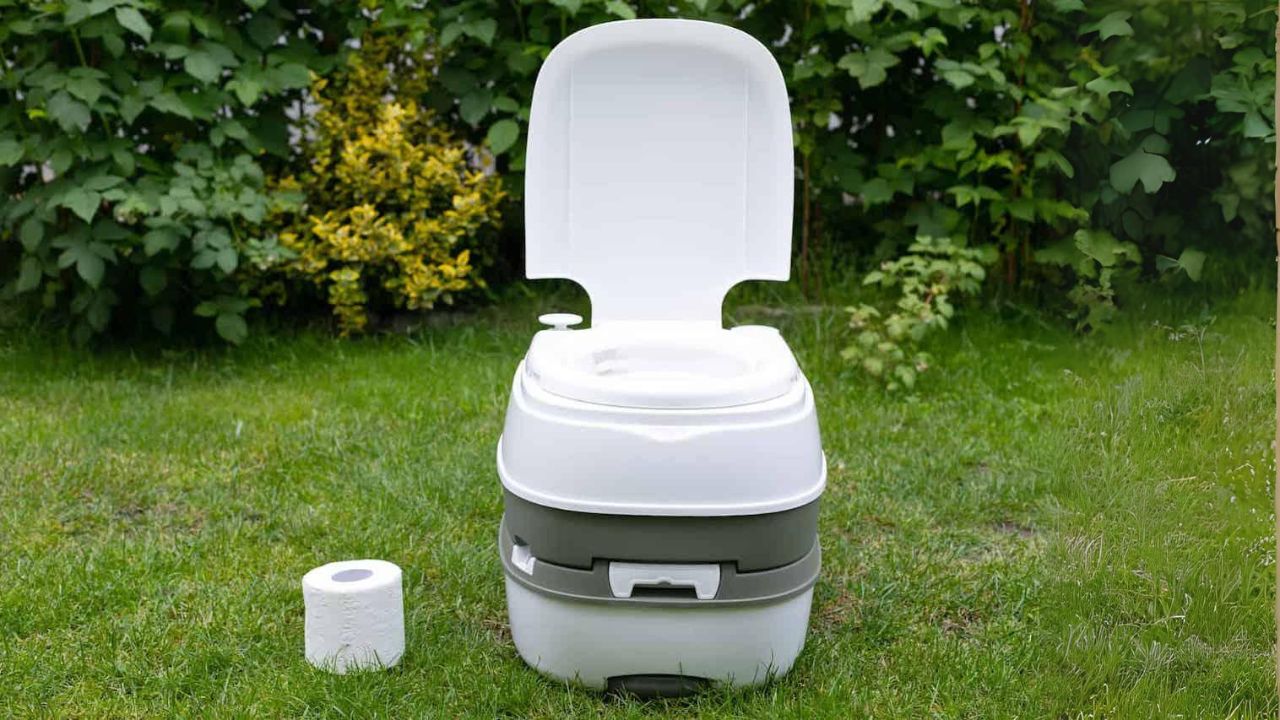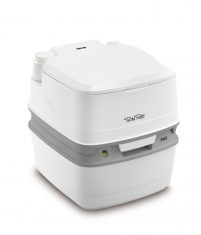Roughing it in the great outdoors doesn’t mean you have to rough it in the bathroom. Portable camping toilets provide a convenient, comfortable, and sanitary bathroom solution while camping, RVing, or living the van life.
But how do these compact toilets actually work? This in-depth guide will walk you through everything you need to know about portable camping toilets.
What Exactly is a Portable Camping Toilet?
A portable camping toilet is a type of toilet that combines a toilet seat/bowl and removable waste holding tank into one compact, portable unit. Unlike an outhouse or pit toilet, a portable camping toilet is completely self-contained.
The key components of a portable camping toilet include:
- Toilet seat and bowl
- Waste holding tank
- Fresh water tank
- Flushing mechanism
- Waste valve for emptying
Portable toilets come in many shapes, sizes, colors, and styles. The most basic designs look like rectangular buckets with toilet seats attached. More advanced models resemble residential toilets with curvy bowl shapes.
Sizes range from compact 2-3 gallon units to larger 5-6+ gallon capacities. The tank size determines how many uses you can get before needing to empty.
Portable camping toilets are designed for easy transport to campsites, RVs, vans, tents, boats, and any outdoor destination.
How Do Portable Camping Toilets Work?
While designs vary across models, most portable camping toilets operate on the same basic principles:
Before First Use
- Add water to the freshwater tank. This supplies the water for flushing the toilet.
- Add toilet chemicals to both tanks. Chemicals help break down waste and control odors. Follow dosage on packaging.
- Secure tanks together properly. Misalignment can cause leaks.
Using the Toilet
- Sit on the toilet as normal and close the lid.
- Flush to open the waste valve. Gravity pulls waste into the holding tank.
- Add more water as needed before flushing again.
Most portable toilets use gravity flow for flushing. Some models have electric pumps for flushing. Choosing manual vs electric comes down to personal preference.
Emptying the Waste Tank
- When full, carefully separate the waste tank from the upper toilet.
- Put on gloves and securely seal the tank’s dump valve.
- Carry the tank to an approved RV dump station.
- Attach dump nozzle and drain waste. Rinse the tank thoroughly.
- Add chemicals and reattach to the toilet.
It’s critical to empty the waste tank only at designated RV dump stations and not just anywhere outside. Concentrated waste and chemicals can harm the environment.
Cleaning and Maintenance
- Rinse out waste tanks after each dump.
- Periodically clean all components with mild soap.
- Use rinse water and toilet chemicals liberally with each flush.
- Replace flush mechanisms as needed over time.
Proper use and maintenance will maximize your portable toilet’s lifespan and prevent nasty clogs or odors.
Types of Portable Camping Toilets
There are 3 main types of portable camping toilets:
1. Bucket Toilets
The simplest portable toilet is the bucket toilet. This is literally a 5-gallon bucket fitted with a toilet seat. Bucket toilets are very affordable and lightweight. However, they offer minimal comfort and need to be lined with a trash bag.
2. Collapsible Toilets
Collapsible portable toilets fold up for compact storage and transport. They often have detachable bags to collect waste. These are a slight step up from bucket toilets but still very basic.
3. All-In-One Toilets
All-in-one portable toilets are the most advanced and comfortable type. As described previously, these combine the seat, bowl, water tank, and waste tank together into one unit. All-in-one portable toilets come in many sizes and designs.
Many RV and van lifers prefer all-in-one portable toilets for their convenience. They operate very similarly to residential toilets. The waste just goes into an onboard holding tank instead of a sewer line.
Popular Portable Toilet Brands and Models
Several brands dominate the portable toilet market. Here are some of the most popular models among campers and RVers:
Thetford Porta Potti
One of the most widely used portable toilet brands, Thetford offers several Porta Potti models like the flagship Porta Potti 365. Features include a 5-gallon waste tank, battery-powered flush, water level gauge, rotating pour-out spout, and carrying handle.
Camco Standard Portable Travel Toilet
For a basic, affordable portable toilet, Camco’s standard model is a best seller. It has a 2.6-gallon holding tank and costs under $100. The one-piece body is detachable for easy dumping.
This covers some of the standout models, but there are many more quality options across different price ranges and capacities. Carefully compare features and reviews to choose the best portable toilet for your needs.
Benefits of Portable Camping Toilets
Why use a portable camping toilet instead of makeshift solutions like catholes? Here are some excellent benefits:
- Convenience – Portable toilets provide a familiar bathroom experience anywhere. No more difficult squatting behind trees or bushes.
- Comfort – Portable toilet seats offer much more comfort and stability than logs or rocks. Some even have height adjustment.
- Weatherproof – Get protection from rain, wind, cold, heat, and insects unlike with outdoor privies.
- Privacy – Portable toilets can be placed in tents or vehicles for privacy. Makes bathroom breaks less stressful.
- Sanitary – Enclosed waste tanks prevent contamination of water and food. Chemicals help control odor and break down waste.
- Compact Size – From 5 to 20+ pounds, portable toilets are designed for easy transport and storage.
- Self-Contained – No fixed installation required. Bring your bathroom anywhere.
- Better for Environment – Contained human waste reduces the spread of bacteria and contamination of water sources compared to primitive campsites.
With the right portable toilet, you can comfortably and safely take the bathroom anywhere off-grid.
Portable Toilet Capacities and Runtime
When selecting a portable camping toilet, the waste tank capacity is an important factor. Tank sizes range from under 3 gallons for basic models to up to 5-6 gallons for larger units.
Bigger tank = longer runtime between dumps. But larger tanks are bulkier and heavier when full. Pick the smallest tank that realistically fits your usage needs. Keep in mind:
- 2-3 gallon capacity = good for 1 person for 2-3 days
- 5-gallon capacity = suitable for 2 people for 2-4 days
- 10+ gallon capacity = ideal for families or longer stays off-grid
For extended boondocking, multiple portable toilets allow longer between dump runs. Bringing extra waste tanks can also extend your runtime. Understand your expected usage and choose a capacity accordingly.
Proper Waste Disposal and Toilet Chemicals
Using and maintaining a portable camping toilet properly is critical for safety and sanitation. Here are some key guidelines:
Disposing of Waste
- Only empty portable toilet waste at designated RV dump stations, never randomly outside.
- Many campsites have a “Chemical Disposal Point (CDP)” specifically for portable toilets.
- Some campsites only permit certain chemicals, like formaldehyde-free options.
- Avoid getting waste on your hands. Wear gloves and sanitize after handling waste tanks.
Using Toilet Chemicals
- Use toilet chemicals in both waste and freshwater tanks. This breaks down tissue, controls odors, and prevents buildup.
- Most toilet chemicals are blue or green. The green chemicals are more eco-friendly.
- Add chemicals each time you dump the waste tank and replenish the fresh water.
- Overuse of chemicals can damage tanks and plumbing. Follow dosage instructions.
- RV-specific chemicals work best. Don’t use household cleaners.
With proper disposal and chemicals, you can keep your portable toilet hygienic.
Emptying and Cleaning Portable Toilets
While not the most glamorous task, emptying and cleaning your portable toilet is essential. Follow these steps:
Emptying the Waste Tank
- Remove the tank from the toilet and seal the dump valve cap securely to prevent leaks.
- Carefully carry the tank to a dump station, grasping the handles only. Wear gloves if needed.
- Attach the dump nozzle adapter and drain the waste completely. Rinse the tank thoroughly with water.
- Add more chemicals to help cleanse the tank interior.
- Reattach the tank to the toilet, ensuring the latches are fully locked.
Deep Cleaning
- Every couple of weeks, give your portable toilet a thorough deep clean.
- Remove tanks and use a mild detergent to scrub the interior of the waste tank. Use a non-abrasive pad or sponge.
- Rinse the fresh water tank with water and baking soda.
- Wipe down external surfaces with soapy water or disinfectant.
- A thorough periodic cleaning prevents buildup and extends your toilet’s life.
Standing waste can corrode and damage tanks over time. Regularly rinsing out your waste tank keeps it fresh and odor-free.
Portable Toilet Tips and Troubleshooting
Here are some handy tips for using your portable camping toilet successfully:
- Empty waste tank when it’s around 2/3 full max. This prevents spills or messes.
- Bring extra water for liberal flushing and rinsing waste tank. This prevents buildup.
- Ensure waste and freshwater tanks are secured together correctly to prevent leaks.
- Add more water to the bowl before each flush for a stronger rinse.
- If pressure builds up in tank, open pressure relief valve before flushing. This prevents backsplash.
- If toilet becomes clogged, close valve, fill bowl with warm water, and use a plunger to clear blockage.
- Replace flush mechanisms, gaskets, and seals periodically for optimal performance.
The Takeaway
Hopefully, this guide gave you a comprehensive overview of how portable camping toilets work and how to use them properly. The key takeaways include:
- Add chemicals and water before first use
- Flush after use to empty waste into holding tank
- Empty tank only at designated RV dump stations
- Use chemicals in both tanks to control odor and break down waste
- Rinse out waste tank after each dump
- Periodically clean all components thoroughly
- Choose tank size based on expected usage
With proper operation and cleaning, a portable toilet provides a comfortable, private, and sanitary bathroom solution for all your outdoor adventures. The range of models means you can find a portable toilet suited for any camping lifestyle and budget.

Diana Miller, is a dedicated nature enthusiast and an outdoor adventurer. She began leading groups for excursions in her teens and never stopped. Following her passion for nature, she gathers her friends for outdoor trips every now and then. And for the last 10 years, she has executed workshops on backpacking, snow kayaking and traveling that included her main motive of lightweight packing while outdoors. During leisure, she loves planning for her next adventure.










Leave a Comment